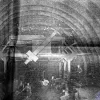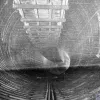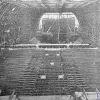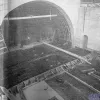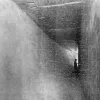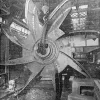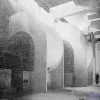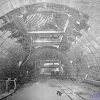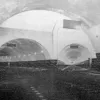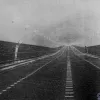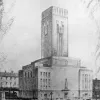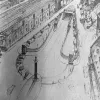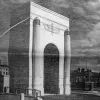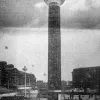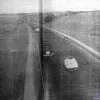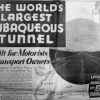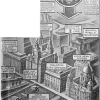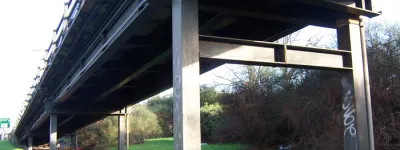The bridge plan was short-lived. The suspension bridge (shown in blue on the map above) would have to be of a sufficient height to clear shipping and its main span would be more than 3,000ft (900m). When the proposal was publicised in September 1923, the tunnel was costed at £6,400,000 while the bridge was £10,550,000. The resulting working party was therefore named the Mersey Tunnel Joint Committee.
In March 1925, Birkenhead offered funding on the strict condition that no trams were to be run in the tunnel. Wallasey offered some selfish conditions which were rejected, and so the lengthy (and costly) Wallasey branch was unceremoniously dropped. The scheme proceeded as a Birkenhead and Liverpool joint project. With the trams gone, a suggestion was made that horse traffic use the lower deck.
January, 1929: the "mechanical erector" is used to place the cast-iron tunnel lining sections in place. It appears to be a lifting arm that rotates and extends in order to lift a piece of lining and push it into place for fastening. The incredible size of the tunnel and equipment is only clear when you realise there are several tiny people in the foreground and working on top of the machinery.
February, 1931: the full circle of the tunnel, awaiting its road deck, looking from Birkenhead towards Liverpool. It's not clear what the suspended wooden structure at the top is for; it may simply have kept cables and pipes out of the way.
April, 1931. The reinforcing bars are in place ready for the concrete road deck to be poured on this section near to Liverpool. It looks like the tunnel mouth is visible in the distance. In the foreground two sets of temporarily rail tracks are visible, used to move equipment through the site.
June, 1931 and the reinforced road deck has made it into the daylight. Presumably the entrances were the last to be completed as they seal off access to the parts of the tunnel below the road deck. This area is now only accessible through a small hatch.
January, 1931, a lonely worker inspects the concrete somewhere far beneath the Mersey. This the southern side of the lower deck, inside one of two ventilation shafts. The small holes in the ceiling are "airports" — not in the modern sense, of course. They allow air to circulate from the traffic space above into the duct.
The Queensway required everything on a huge, unprecedented scale. The ventilation system — required to evacuate the fumes from very smoky early twentieth century road traffic running underground for long distances — was legendary in scale. This is just one of the enormous fan blades, being erected at John Street in Liverpool.
At Sidney Street, this could be a scene from the film Metropolis, but it's actually two of the enormous fan housings above ground. Again, the sense of scale is provided by two small people to one side.
February, 1932 and the view from inside the tunnel where the exhaust pipe to North John Street ventilation station enters the shaft. The pipe visible above sucks air from the tunnel using the heavy plant in the previous pictures.
The completed tunnel shortly before opening in 1934, with the lofty junction chamber near the Birkenhead end. To the rear, the main bore runs to Liverpool; ahead the tunnel splits with one four-lane branch to Birkenhead and one two-lane branch to Rendel Street. The latter was closed in 1965. Note the direction signs suspended above the roadway and the lack of traffic control.
The main tunnel beneath the Mersey, with elegant lighting embedded in the tunnel walls. (Today the tunnel is lit from an ugly overhead gantry.) The four lanes are marked out quite strangely — the middle two appear to be considerably wider. In the financial year 1939-40, there were 1,925 broken down vehicles rescued from the tunnel, so it made sense to have space to pass stricken vehicles.
The Liverpool ventilation building, seen here in an architectural sketch, stood near to some of the city's architectural treasures (particularly the Liver and Cunard buildings) and so was designed to be something remarkable in its own right.
The Chester Street entrance in Birkenhead. The road layout is very trusting, with nothing to stop vehicles entering through the wrong side of the toll plaza and getting a free journey.
The Old Haymarket entrance in Liverpool, with a slightly different design. Above the tunnel portal is a decorative floor mosaic, and in the foreground the bus station might be a hint at the plans to run scheduled buses through the tunnel. This was strongly opposed by Birkenhead and only happened relatively recently.
One of the "architectural pylons", to the west of the tunnel mouth at Birkenhead. Just behind it is one of the toll booths.
The "central lighting pylon" at the Liverpool tunnel entrance. In the background the familiar shapes of the Liverpool Museum and Art Gallery can be made out. This structure was sadly dismantled in the 1960s, but its counterpart in Birkenhead is still standing.
Liverpool was the second city of the United Kingdom in 1934 and the largest port in the British Empire, and as such was undergoing enormous development. As well as the Queensway Tunnel, it also received the Liverpool to East Lancashire Road, one of the first new inter-city roads built in Britain, which opened in the same year. This (unfortunately faded) image shows its original state, with three unmarked traffic lanes crossing the Lancashire countryside.
Local companies were keen to advertise in the Liverpool Daily Post supplement, and it is sometimes difficult to work out what they are trying to sell you. This one is fairly typical, discussing the tunnel more than whatever company placed it. It proudly proclaims the "world's largest subaqueous tunnel", and opens with the bold statement that "the conquest of the River Mersey is now an accomplished fact", heralding a travel time of 6½ minutes.
The Corporation of Liverpool placed a full-page advert trumpeting the city's merits in language that would be considered unusual today. This extract, with a stylised aerial view of the city, is labelled with "greatest airport in the north", "great £8,000,000 Mersey traffic tunnel", "unlimited supplies of cheap water electricity and gas" and "wide stretches of level country available for immediate industrial development".
Picture credits
- Photographs of construction and opening from a Liverpool Daily Post supplement published 16 July 1934, now believed to be out of copyright.
With thanks to Iain Ellis for information on this page.
